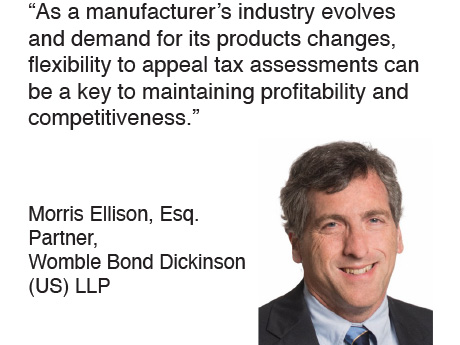COVID-19 laid bare many problems inherent in offshore supply chains and spurred widespread interest in reshoring manufacturing to the United States. As companies and communities explore site selection and expansion opportunities, they should remember that manufacturing profitability often hinges on tax strategy.
Staging a comeback
For the first time in decades, industry and the public sector are working to make American manufacturing competitive in a rapidly changing global marketplace. The recent enactments of the Inflation Reduction Act, the Bipartisan Infrastructure Law and the CHIPS and Science Act have directed billions of dollars into enhancing domestic manufacturing capacity.

The semiconductor industry presents a high-profile case study. The United States holds 12 percent of the world’s semiconductor manufacturing capacity, eroded from 37 percent in 1990. The CHIPS Act’s $52 billion in federal funding is intended to strengthen domestic semiconductor manufacturing, design and research and reinforce the nation’s chip supply chains, fortifying the economy and national security along the way.
Simultaneously, the United States is becoming a leading producer of electric vehicles and vehicle battery plants. Since 2021, announced U.S. investments in semiconductors and electronics exceed $166 billion, and announced U.S. investments in electric vehicles and battery manufacturing exceed $150 billion.
Deciding where manufacturing occurs depends partly on proximity to suppliers, available labor, distribution hubs and customers, and operating costs. Property tax is typically a significant component of operating costs. That’s why tax abatements on real property and equipment are a commonly offered incentive.
Most states offer incentives to attract industry, and one of the hotbeds for increased American manufacturing has been the Southeastern United States, specifically South Carolina, Georgia and North Carolina. All are leaders in foreign direct investment.

Abatements generally provide a manufacturer with predictable property taxes, helping to overcome the uncertainty of future tax liability that can put companies at a disadvantage. An example is South Carolina’s “fee in lieu of tax” agreement (FILOT) which offers manufacturers predictable and consistent taxation. Generally, FILOT agreements fix tax rates and the value of real estate and improvements for the length of the agreement, while allowing manufacturers to depreciate the value of machinery and equipment.
FILOT agreements can have up to a 50-year term. However, by fixing a manufacturer’s real property value at actual cost without depreciation, the owner’s taxes over time may be higher than they would be without the agreement. That’s because they do not account for depreciation, valuation changes or required improvements to accommodate changes in the marketplace for the manufacturer’s product.
By locking in the real property value, the manufacturer receives the benefits of predictability and protection from higher taxes on appreciating real property. In exchange, however, the manufacturer loses the benefit of any depreciation and takes the risk of a locked-in property value if the property’s market value diminishes.
Other states offer different incentives including more traditional property-tax abatements, where a manufacturer receives a grant as a partial rebate or discount on the new property taxes the project creates. Since tax rates and taxable value assessments change over time, these systems can provide less certainty for manufacturers than FILOT-type agreements, but potentially offer more long-term flexibility to respond to changing tax rates, depending on how the agreements are negotiated.
As a manufacturer’s industry evolves and demand for its products changes, flexibility to appeal tax assessments can be a key to maintaining profitability and competitiveness.
Committed but flexible
Certainly, a manufacturer is better off in an appreciating real estate market by fixing the value of the real estate and improvements. Organizations negotiating for incentives should protect their ability to protest unfair assessments of taxable value, however, because valuing a manufacturing plant in the traditional ad valorem system is challenging and subject to controversy.
For example, most state ad valorem property tax systems define “value” as a variant of “market value,” assuming an exchange between a willing buyer and a willing seller. However, will the buyer of a manufacturing facility benefit from the features of a specialized building constructed for a different manufacturer’s specific needs? The answer is usually “no.”
Manufacturing facilities are special-purpose properties, which The Dictionary of Real Estate Appraisal defines as a “property with a unique physical design, special construction materials, or a layout that particularly adapts its utility to the use for which it was built.” And changes in the manufacturing process can render many buildings economically obsolete.
If the facility’s use is no longer viable, it should be appraised as an alternative use. This necessarily occurred as American industry declined. Often there were no manufacturers who could effectively use single-purpose buildings vacated by other manufacturers, necessitating drastic value reductions.
An assessor’s three traditional valuation methods all have limitations. A sales comparison approach is difficult when the production facility has essentially been designed to produce specific products. Put differently, finding sales of comparable facilities can be extremely challenging.
An income approach requires a market rent calculation, but manufacturers historically own their facilities, making an income approach difficult. A cost approach using actual cost ignores that the same building might not be appropriate to respond to changes in the marketplace for the product being produced. The cost approach without depreciation also limits the manufacturer’s flexibility in responding to changes in the marketplace for its product.
Remember, too, that a manufacturer must be nimble, as changes in the market or technology can render an entire plant (or industry) obsolete virtually overnight. Adapting processes may require equipment upgrades or replacement, structural modifications or other changes that affect property value.
The speed at which manufacturers need to be able to adapt to a changing marketplace, the strong desire for certainty in costs and the difficulties in valuing manufacturing facilities for tax purposes all argue in favor of valuing real property and improvements on the basis of cost less depreciation.
Successful reshoring will require focused efforts by the public and private sector, together with sensitivity to industry’s need to be nimble and the implications of historical incentives to ensure that reshored industry remains competitive. Flexibility offers the key to long term success, and property taxes form an important piece of the puzzle.
Those cities and states looking to maintain or increase their manufacturing footprints should be mindful of this lesson in packaging incentives to attract and maintain manufacturers, and manufacturers should think critically about the valuation of their facilities for property tax purposes when evaluating competing incentive offers.
Morris Ellison is a partner in the Charleston office of law firm Womble Bond Dickinson (US) LLP, the South Carolina member of American Property Tax Counsel, the national affiliation of property tax attorneys. He can be reached at morris.ellison@wbd-us.com. Whit McGreevy is an associate at the firm. Reach him at whit.mcgreevy@wbd-us.com.


